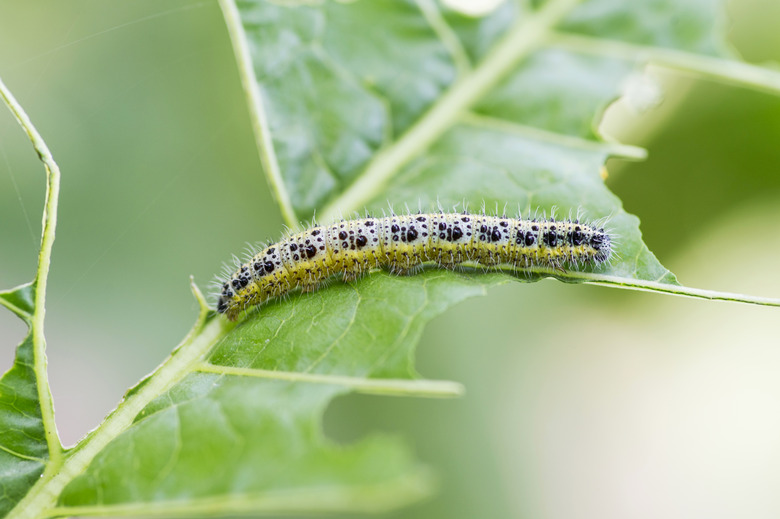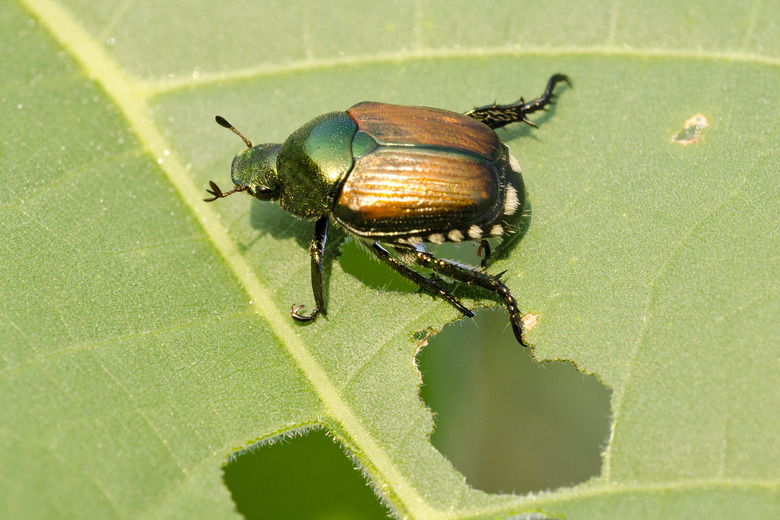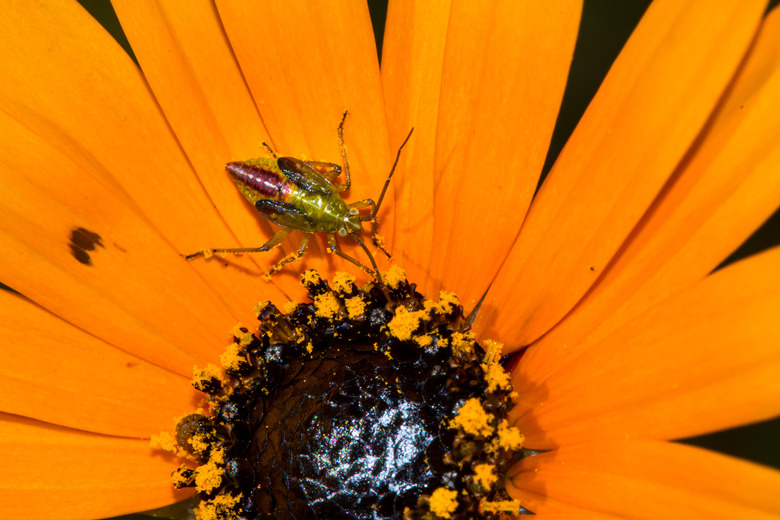How To Deal With The 6 Most Common Garden Pests
We may receive a commission on purchases made from links.
If you have a garden, you have garden pests. Most of the time, this isn't a problem — you go your way, and the insects in your garden go their way. Everybody is happy. Sometimes, however, insect pest populations get out of control, causing an infestation and big problems for your garden.
When this happens, you'll have to take action if you want to save your plants. It's important, however, that you try to protect beneficial insects, like honeybees, while you're removing the harmful creatures. Start with the safest and most natural ways to eliminate pests using chemicals only when all else fails. Try and target your pest control efforts as well, treating only problem plants and specific pests whenever possible in order to keep healthy plants in your vegetable garden, herb garden or flowerbed.
1. Aphids
1. Aphids
Unless you have a toddler, it's difficult to fathom how critters so small can do so much damage. One of the most common garden pests in the United States, aphids are 1/16 to 1/8 inch long with pear-shaped bodies and two little protrusions that look like tailpipes. They can be green, black, red, yellow, brown or gray in color. They may be small, but they're mighty in large numbers.
Aphids cause damage by feeding on the juices in plant leaves. The result is leaves that twist, curl and turn yellow. An aphid problem can also stunt a plant's overall growth.
To prevent aphids in the first place, keep your garden free of weeds. Aphids will feed on weeds as readily as they do ornamental and food crops, and sowthistle and mustard are particularly good at sustaining aphid populations. Once you have aphids, it's easy to remove them by shooting them off the plant with a stream of water from the garden hose sprayer.
If the problem persists, aphids are easily defeated with an application of insecticidal soap. Spray the soap liberally and make sure you cover the entire plant; sometimes, aphids like to hang out on the underside of leaves. You don't want to damage your plants, however, by using insecticidal soap. Be sure to read the label directions for a list of sensitive plants that may be injured by insecticidal soap.
2. Caterpillars and Cutworms
2. Caterpillars and Cutworms
Cutworms and caterpillars look very much the same, and you can use the same techniques to rid yourself of both of these garden pests. Caterpillars leave holes and damage along the edges of leaves where they feed. Some even burrow into fruits and vegetables, making them quite unappetizing.
To prevent caterpillars, cover young plants with floating row covers. These work well for keeping moths and butterflies from laying eggs on your plants so the hatchling caterpillars can't eat them. You need to remove the covers when your plants flower so that pollinators can reach them, realizing some of these pollinators are the moths and butterflies that are laying eggs on your plants that hatch into caterpillars.
Some moths lay their eggs on the ground around the base of plants, which hatch into cutworms. You can make cutworm collars by placing a vertical wall of cardboard or aluminum foil around the base of your plant so the hatchling cutworms can't climb the stems to feed on your plants. A sprinkling of diatomaceous earth around your plants can also solve caterpillar problems.
If you already have caterpillars or worms on your plant, handpick them and drop them in a dish of soapy water to kill them. You can also encourage birds to visit your garden and eat your caterpillars. To do so, set up a bird feeder and a birdbath to make your garden more inviting to feathered friends.
If all else fails, purchase the insecticide Bt (Bacillus thuringiensis). Bt is a natural microorganism found in soil that kills soft-bodied and larval pests. It is safe, however, for humans, children and pets.
3. Japanese Beetles
3. Japanese Beetles
One-half inch long and colored a metallic blue-green, Japanese beetles are one of the worst garden pests. Although they especially love roses, Japanese beetles will eat over 300 plant varieties. When they do, they leave behind skeletonized leaves, eating the fleshy part and leaving the veins that run through the leaf.
Unfortunately, the most effective way to eliminate Japanese beetles is to pick them off the plant by hand and drop them in a dish of soapy water. This is time-consuming and not fun if you're a little squeamish about insects. You can also spread a tarp or blanket underneath your plant, shake off the beetles and then dump them into soapy water (you just have to be fast enough to wrangle them before they fly away).
Many gardeners use Japanese beetle traps to protect their gardens, but be aware that beetle traps are a double-edged sword. They can attract more beetles, so you must keep them at least 25 feet away from your garden. You can buy traps at the hardware store, or you can make your own. To do so, open a can of fruit cocktail and let it ferment in the sun for a week. Place the fruit cocktail can on top of a brick at the bottom of a light-colored bucket and then fill the bucket with water until it sits just below the can.
If you want to try and prevent Japanese beetles, place a row cover over your plants during the six to eight weeks of the year that the beetles actively feed. In the South, this period begins in the middle of May. In the North, it begins in mid-June. If your garden is too big to cover, apply a grub control product early in spring to kill grubs before they mature and start to feed.
4. Slugs and Snails
4. Slugs and Snails
Technically, slugs and snails aren't insects but mollusks. They can prove to be quite problematic in the garden, however, and they are definitely garden pests. Slugs are slimy and gray, black or brown in color. They can be as small as 1/2 inch or as large as 3 inches. Snails look almost exactly like slugs except that they carry a shell on their back.
Slugs and snails typically leave behind leaves with holes, but in some cases, they will shear off an entire leaf. Because their slimy bodies can't handle the sun, you'll likely see only the damage and not the pests themselves since they typically feed at night. If you want to look for snails and slugs, do so early in the morning or at night. If you see any, pick them off your plant and drown them in a cup of water or dry them out with salt.
Slugs need protection from the hot sun, so they'll seek shelter under rocks, mulch and whatever else they can find in your garden. If you have a slug or snail problem, lay a few small boards in your garden. During the day, the slugs will hide under the wood, and you can simply flip it over and collect them.
If you prefer a more hands-off approach, sprinkle diatomaceous earth around your plants. This will kill any soft-bodied animals that try to cross it. You can also set up beer traps. Sink a few shallow pans into your garden so that the top of the pan is level with the ground and then fill it with beer. The slugs will come in for a drink, get stuck and drown. The slugs are attracted to the yeast, so as an option to using beer you can simply mix yeast in water to make a slurry, and bait your traps with this. Empty and refresh your traps twice a week.
If you start to feel like you aren't making any progress, you can use pesticides to treat slugs and snails. Choose a product that contains iron phosphate, as it is safe for humans and animals. Iron phosphate is also labeled as safe to use on vegetables.
5. Whiteflies
5. Whiteflies
As their name suggests, whiteflies are tiny, white, triangular-shaped insects that look like flies. They're only 1/16 to 1/10 inch long and often appear to have a powdery texture. In cool climates, whiteflies tend to be problematic only late in the summer when the weather gets hot. In warmer areas, whiteflies are more common since they are better able to survive the winter.
Though small, whiteflies can cause quite the pest problem, as they feed aggressively on plant nectars. This almost constant feeding can reduce a plant's health very quickly, leaving it wilted and defoliated. The plant will lose its overall vigor as well, and the flies will stunt its growth.
Unfortunately, whiteflies are tough to eliminate, so you may have to try more than one control method. To help slow them down, carefully inspect any new seedlings or young plants you buy before planting. Remove any leaves that are hosting whiteflies. This keeps you from bringing more whiteflies into the garden. Inspect your established plants periodically as well and remove whitefly-hosting leaves or stems.
Whiteflies have a lot of natural enemies, including ladybugs and spiders. Ask your local garden center what ladybug-attracting plants will grow well in your area and plant them liberally. Do not, however, buy ladybugs or other insects online and then release them into your garden. This unnaturally raises insect populations and can ruin nature's balance in your garden and the surrounding areas.
You can also trap whiteflies by coating a yellow paper with a sticky substance, like petroleum jelly or a product called Tangle-Trap. Hang the traps vertically near the affected plants to lure the whiteflies and get them stuck on the trap. You may need to use one trap per plant, so don't skimp.
Ultimately, you may have no choice but to use chemical pesticides to control whiteflies. Whiteflies have developed a resistance to some chemicals, however, so you may have to try more than one pesticide. To get the best results, choose a pesticide and apply it as directed, checking the label to make sure your target plants won't be damaged because of their sensitivity to the pesticide. If you still have whiteflies after four or five applications, try a different pesticide.
When choosing a pesticide, talk to your local garden center or extension office first for recommendations. Whiteflies have developed resistance to certain pesticides, but this can vary by area. A whitefly treatment that works for your sister in the next state over may not work in your area. Consulting your garden center gives you a good starting point rather than choosing a chemical indiscriminately and hoping for the best.
6. Thrips
6. Thrips
Thrips are tiny insects found in shades of brown and green. Also called thunderflies, thrips are only about as wide as a sewing needle. Like aphids, thrips are sucking insects that pull the nectar out of tender leaves. Most often attracted to light-colored leaves and flowers, they can leave behind silvery or splotchy-looking foliage. The bigger issue, however, is that they often carry plant diseases and transmit the pathogens to plants as they feed on them.
Fortunately, controlling thrips is fairly easy. The first step is to clean any yard waste or debris, as this will give thrips a place to hide while you treat your garden plants. Then, use a garden hose to knock the thrips off your plants just as you would for aphids. After giving your plants a cleansing shower, hang blue or yellow sticky traps around the garden to attract and capture the thrips.
If thrips still persist, treat your plants with insecticidal soap as long as your plants aren't listed on the label as potentially suffering damage from being sprayed with the soap. Spray your plants twice, three days apart, or according to label directions if they vary from this recommendation. This will usually eliminate thrips.
References
- University of Minnesota Extension: Aphids in Home Yards and Gardens
- The Old Farmer's Alamanc: Aphids – How to Identify and Get Rid of Aphids
- National Pesticide Information Center: Bacillus Thuringiensis (Bt)
- The Old Farmer's Almanac: Japanese Beetles – How to Get Rid of Japanese Beetles in the Garden
- Missouri Botanical Garden: Slugs and Snails
- Missouri Botanical Garden: Whitefly – Outdoors
- The Old Farmer's Almanac: Thrips – How to Identify and Get Rid of Thrips
- Gilmour: Common Garden and Lawn Pests
- Better Homes & Gardens: 10 Common Garden Pests to Watch for and How to Get Rid of Them


